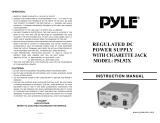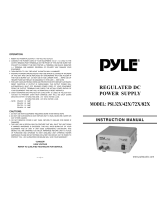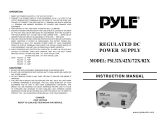Inductive loads, such as TVs and stereos, require more current to operate than do
resistive loads with the same wattage rating. Induction motors, as well as some TVs,
may require two to six times their rated wattage to start up. Because the MAXX
SST™ inverters have a peak watt power rating, many such appliances and tools
may be safely operated. The equipment that needs the highest starting wattage are
pumps and compressors that start under load. This equipment can be safely test-
ed. If an overload is detected, the inverters will simply shut down until the over-
load situation is corrected. Use the front panel switch to turn OFF the inverter,
then ON, to reset the inverter.
CAUTION: NO USER-SERVICEABLE COMPONENTS INSIDE.
OPENING UNIT WILL VOID WARRANTY.
4.2 DETERMINING BATTERY SIZE:
To determine the minimum battery size that you will need to operate appliances
from MAXX SST™ Models, follow these steps:
1. Determine the wattage of each appliance and/or tool you will need to
simultaneously operate from the inverter. To do this, read the labels on the
equipment to be operated. Usually, power consumption is shown in watts. If
it is shown in amps, multiply by 110 to determine the wattage.
2. Estimate the number of hours the equipment will be in use between
battery recharges.
3. Determine the total watt-hours of energy use, the total running time and the
average power consumption.
To get an estimate of the current (in amps) that the battery must be capable of
delivering, divide the load consumption power (in watts) by (10). Keep in mind
that most appliances are not operating for long periods of time. For example,
a typical home-use coffee maker draws 500 watts during it’s brew time of 5
minutes, but it maintains the temperature of the pot at about 100 watts. Typical
use of a microwave is only for a few minutes, sometimes at low power. Some
exceptions to brief operating times are lamps, TVs and computers.
4.3 BATTERY OPERATING TIME
FIGURE 6 is a set of curves that show how appliance load in watts or in
amperes affects operating time. These curves are only estimates of operating
time, dependent upon:
• The condition of the batteries
• The state of charge on the batteries
• The amount of other DC appliances drawing current from the batteries
Three curves were developed for a battery of 50 Ampere Hours (AH) capacity,
and three for multiple batteries in parallel. The higher capacity curves are for
120 AH, 200AH and 400AH capacities. These large capacity batteries clear-
ly extend operating time at full load. To extend operating time in general,
reduce the heavy appliance load to a minimum. Remember, you are operating
on stored energy and probably under power loss conditions. All operating time
curves assume permanent installation with the correct DC input wire (See Specs
Page 18) and a full charge on the batteries.
11























